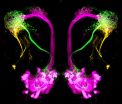(Press-News.org) ANN ARBOR--A set of eight hurricane-forecast satellites being developed at the University of Michigan is expected to give deep insights into how and where storms suddenly intensify--a little-understood process that's becoming more crucial to figure out as the climate changes, U-M researchers say.
The Cyclone Global Navigation Satellite System is scheduled to launch in fall 2016. At the American Geophysical Union Meeting in San Francisco this week, U-M researchers released estimates of how significantly CYGNSS could improve wind speed and storm intensity forecasts.
CYGNSS--said like the swan constellation--is a $173-million NASA mission that U-M is leading with Texas-based Southwest Research Institute. Each of its eight observatories is about the size of a microwave oven. That's much smaller than a typical weather satellite, which is about the size of a van.
The artificial CYGNSS "constellation," as researchers refer to it, will orbit at tropical, hurricane-belt latitudes. Its coverage will stretch from the 38th parallel north near Delaware's latitude to its counterpart in the south just below Buenos Aires.
Because of their arrangement and number, the observatories will be able to measure the same spot on the globe much more often than the weather satellites flying today can. CYGNSS's revisit time will average between four and six hours, and at times, it can be as fast as 12 minutes.
Conventional weather satellites only cross over the same point once or twice a day. Meteorologists can use ground-based Doppler radar to help them make predictions about storms near land, but hurricanes, which form over the open ocean, present a tougher problem.
"The rapid refresh CYGNSS will offer is a key element of how we'll be able to improve hurricane forecasts," said CYGNSS lead investigator Christopher Ruf, director of the U-M Space Physics Research Lab and professor of atmospheric, oceanic and space sciences.
"CYGNSS gets us the ability to measure things that change fast, like extreme weather. Those are the hardest systems to measure with today's satellites. And because the world is warmer and there's more energy to feed storm systems, there's more likelihood of extreme weather."
Through simulations, the researchers quantified the improvement CYGNSS could have on storm intensity predictions. They found that for a wind speed forecast that is off by 33 knots, or 38 miles per hour--the average error with current capabilities--CYGNSS could reduce that by 9 knots, or about 10 mph.
Considering that the categories of hurricane strength ratchet up, on average, every 20 mph, the accuracy boost is "a very significant number," Ruf said.
"I'd describe the feeling about it as guarded excitement," he said. "It's preliminary and it's all based on models. People will be really excited when we get up there and it works."
The numbers could also improve as scientists update weather prediction tools to better use the new kind of information that CYGNSS will provide.
For people who live in common hurricane or typhoon paths, closer wind speed predictions could translate into more accurate estimates of the storm surge at landfall, Ruf said. That's the main way these systems harm people and property.
"The whole ocean gets higher because the wind pushes the water. That's really hard to forecast now and it's an area we hope to make big improvements in," Ruf said.
Researchers expect the satellite system to give them new insights into storm processes. Hurricanes evolve slowly at first, but then they reach a tipping point, says Aaron Ridley, a professor of atmospheric, oceanic and space sciences.
"The hurricane could be meandering across the Atlantic Ocean and then something happens." Ridley said. "It kicks up a notch and people aren't exactly sure why. A lot of scientists would like to study this rapid intensification in more detail. With a normal mission, you might not be able to see it, but with CYGNSS, you have a better chance."
The satellites will operate in a fundamentally different way than their counterparts do. Rather than transmit a signal and read what reflects back, they'll measure how GPS signals from other satellites bounce off the ocean surface. Each of the eight CYGNSS nodes will measure signals from four of the 32 Global Positioning System satellites.
They'll also be able to take measurements through heavy rain--something other weather satellites are, surprisingly, not very good at.
INFORMATION:
Christopher Ruf
Aaron Ridley
CYGNSS
Space Physics Research Lab
Contrary to popular belief, new research suggests that some employees adapt well to pressures caused by changes in the workplace.
Pay cuts, reduced working hours, fewer training and promotion opportunities are just a few of the measures organisations employ to combat economic downturn and industry competition. Where previous research has suggested cut backs result in a demotivated and unhappy workforce, experts from Monash University and The University of Iowa say this might not necessarily be the case.
A new study published in the Journal of Occupational and Organizational ...
A global fleet of composite planes could reduce carbon emissions by up to 15 percent, but the lighter planes alone will not enable the aviation industry to meet its emissions targets, according to new research.
The study, by the Universities of Sheffield, Cambridge and UCL (University College London), is the first to carry out a comprehensive life cycle assessment (LCA) of a composite plane, such as the Boeing Dreamliner 787 or Airbus 350, and extrapolate the results to the global fleet.
The LCA covers manufacture, use and disposal, using publicly available information ...
A team of Chinese and Italian scientists has joined efforts to provide a key to the understudied phaleratus group of blister beetles. During their research the scientists have also discovered a new species from the genus Hycleus, which they named after Marco Polo, as a tribute to their collaboration during the Ph.D. studies. The study was published in the open access journal ZooKeys.
The phaleratus group to which the new species Hycleus marcipoli belongs, is part of the Meloidae family commonly known as the blister beetle family. The representatives of this group get ...
This news release is available in German. Whether an odor is pleasant or disgusting to an organism is not just a matter of taste. Often, an organism's survival depends on its ability to make just such a discrimination, because odors can provide important information about food sources, oviposition sites or suitable mates. However, odor sources can also be signs of lethal hazards. Scientists from the BMBF Research Group Olfactory Coding at the Max Planck Institute for Chemical Ecology in Jena, Germany, have now found that in fruit flies, the quality and intensity of ...
Researchers studied 414 people with severe dementia along with their carers in England, Estonia, Finland, France, Germany, the Netherlands, Spain and Sweden. The study gathered information on quality of life, activities of daily living such as bathing, feeding and dressing and presence of depressive symptoms using standardised measures.
In the groups studied, 37% of the 217 people living in the community showed signs of depression compared to 23% of the 197 in care homes. It is one of the few studies comparing similar groups of people living at home and in nursing homes.
Professor ...
Some neurons are more active than others, even when they are positioned right next to each other and are one and the same neuron type. Dr. Jean-Sébastien Jouhanneau and Dr. James Poulet of the Max Delbrück Center for Molecular Medicine (MDC) Berlin Buch have discovered the cause for this phenomenon. They found that the more active neurons in the somatosensory area of the brain respond to a broader receptive field and probably play a particularly important role in our sensory perception. The findings of the researchers, who also work at the NeuroCure Cluster of ...
People and animals have been shown to discriminate between quantities. Lions, chimpanzees and hyenas, for example, will only approach a group of attackers if their own group outnumbers that of the intruders. These animals use numerical information to make decisions about their social life.
Testing numerical competence
In 2012 Friederike Range and Zsofia Virányi from the Messerli Research Institute at the University of Veterinary Medicine Vienna showed that wolves are capable of discriminating between different food quantities. In their present study, they asked ...
Stimulants use such as cocaine and amphetamine is associated with a nearly two-fold greater likelihood of suicidal behaviour amongst people who inject drugs, say researchers at the University of Montreal and the CHUM Research Centre. Drug addiction had already been identified as a major risk factor for suicide, and it is in fact the cause of ten percent of deaths among drug users. The data from this groundbreaking study could help develop and evaluate more appropriate suicide prevention efforts in this highly vulnerable population.
The researchers were able to explore ...
GPs should consider a more overt discussion with patients when referring them for further investigation of symptoms which may indicate cancer, according to a paper published in the British Journal of General Practice.
In an NIHR-funded study, researchers from the Universities of Bristol, Cambridge, Durham and Exeter conducted interviews with patients being referred for possible lung and colorectal cancer.
They found that patients were rarely involved in the decision to be referred for investigation and that reasons for referral tended to be couched in non-specific ...
WASHINGTON, Dec. 16, 2014 -- It's been a holiday decoration staple for decades, and it turns out that silver stuff hanging from your tree has quite a storied past. Tinsel has been made out of everything from real silver, to lead to other dangerously flammable materials. This week's Speaking of Chemistry decks your halls with the history of tinsel. Check it out at http://youtu.be/fql3aCuu1l0.
INFORMATION:
Speaking of Chemistry is a production of Chemical & Engineering News, a weekly magazine of the American Chemical Society. The program features fascinating, weird and ...



